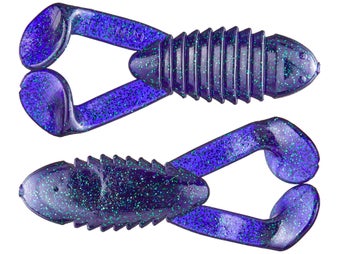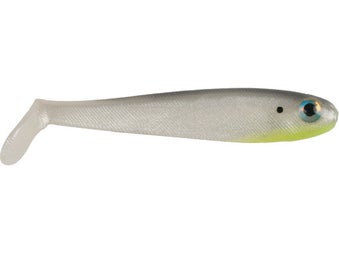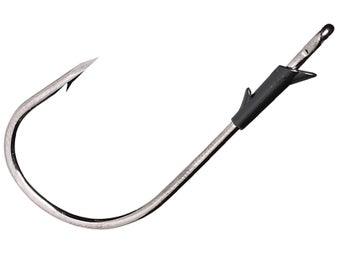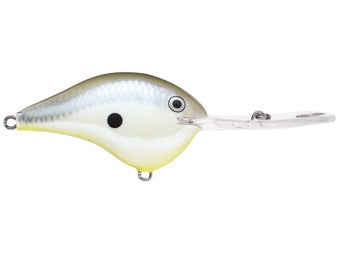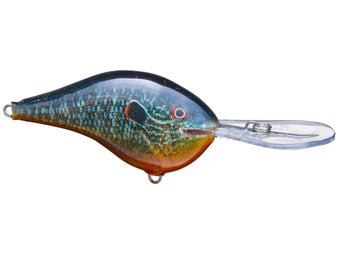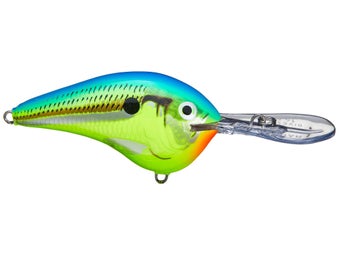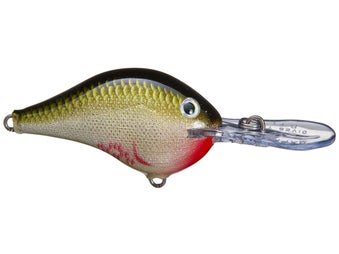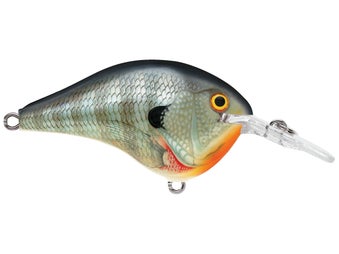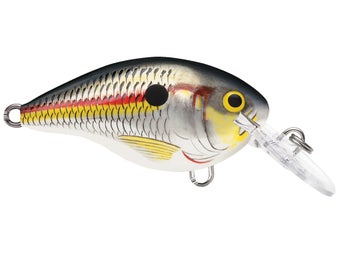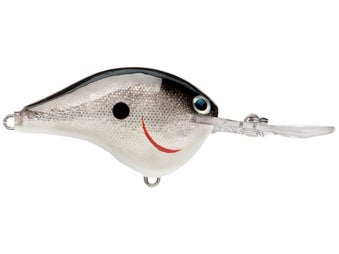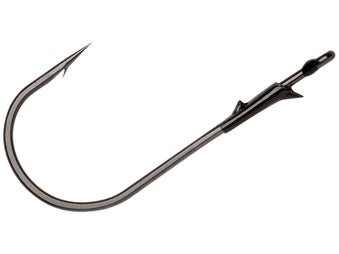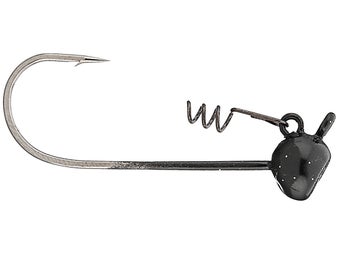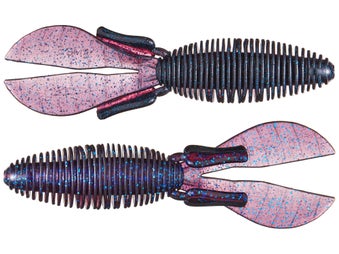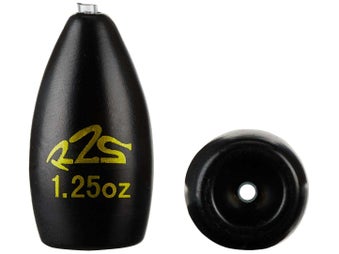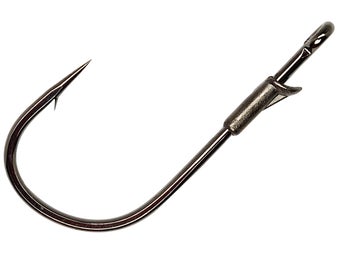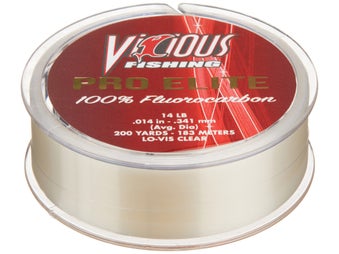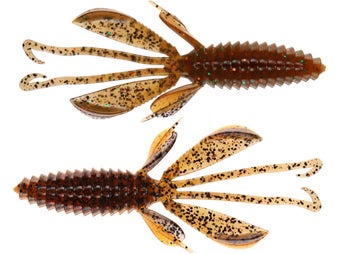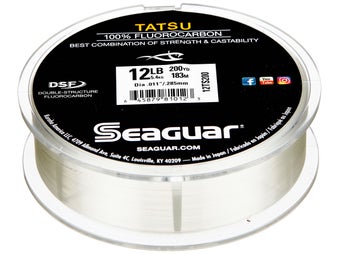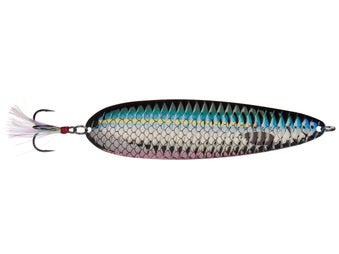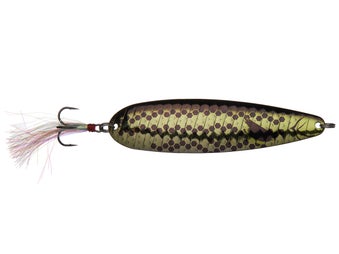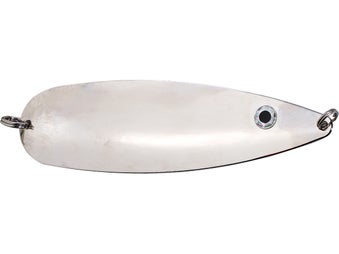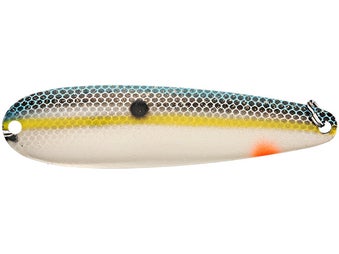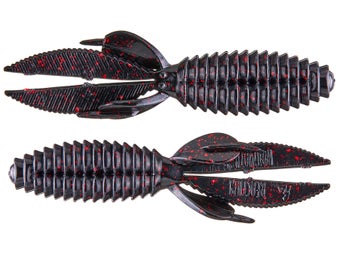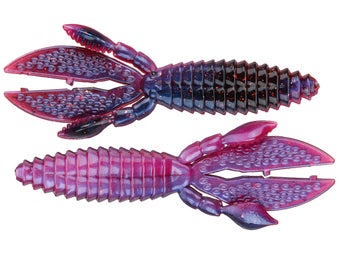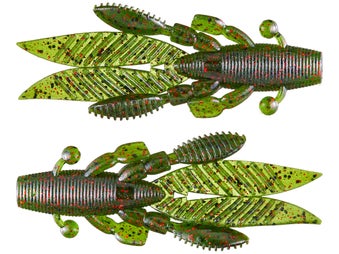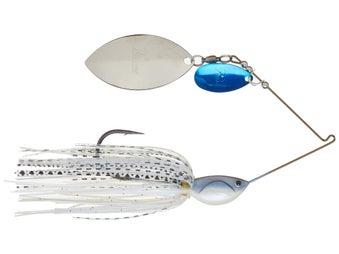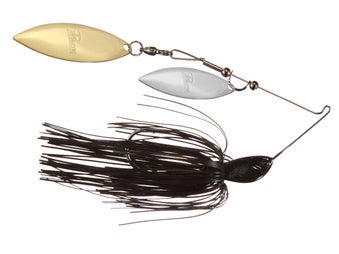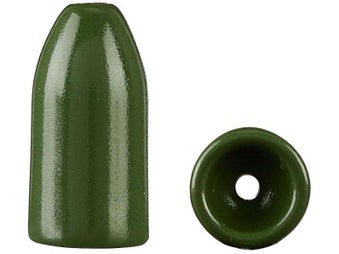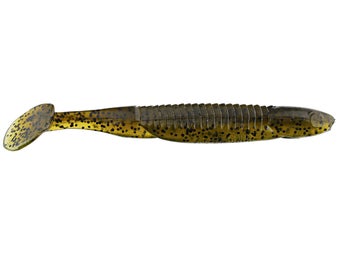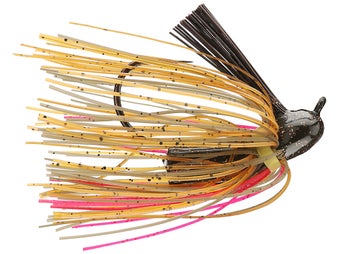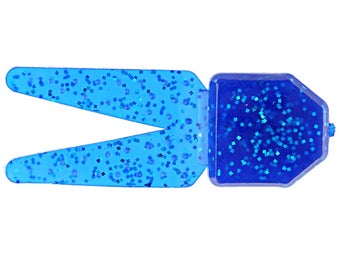Pro's Picks For Summer Bassin'
Froggin' With Chris Lane
Lure Selection & Presentation:
Having already iterated the frog as a fave way to land lunkers, Lane explained the two types of the frog imitations that he uses as toad temptations. "There are two kinds of frog fishing," he stated. "There is the floating frog and there is the swimming frog. A floating frog like the kind made at Snag Proof are made for grass mats. I fish a Bobby's Perfect Frog for this kind of fishing, except at Guntersville. When I'm fishing a floating frog, I'm looking for thick matted grass that the fish are in and work it real slow. When I'm in scattered grass or sparse vegetation by logs, I want a swimming frog. I use a Luck E Strike swimming frog." Lane continued his differentiation of the two types of froggin' as the relate to tidal water saying that he opts to throw a swimming frog on edges of vegetation when the water has moved out and then changes to the floating frog on tops of mats as the water depth rises.
He described the variation on working each type of frog. "With a swimming frog, just reel the entire time unless you see a bass just under it, but not striking," stated Lane. "If you see that, just pause and let it sink a little, then pick right back up reeling and wait for it to explode on it. The floating frog is a reel, twitch, sit, let them come it get retrieve." When setting the hook, Lane always gives a two-second wait time after the frog disappears. If he finds he is missing fish after a blow up, he said, "wait longer." Offering an extra two seconds, before setting the hook could make the difference in those "ones that got away stories".
Chris Lane's Guntersville Frog:
As for the inspiration for the Guntersville Frog that Lane developed with Snag Proof he stated there was no fishery that could compare to his home water, - Lake Guntersville in Birmingham, Ala."We, as fishermen - are funny," said Lane. "We always think we can do something different, something that swims better or has a better hookup or a bigger strike. I knew that was something that could be done with a frog on Guntersville. That place has world-renowned, forage frog fishing. Anything can happen there. It holds big, big bass. The anticipation that an angler feels as soon as you throw that floating frog over a mat, is incredible. "The amount of mats and type of vegetation is the best; there just isn't any place like it. It needed a different kind of frog." He described the mats as thick, but hollow underneath allowing a space for the fish to get up underneath. He explained his ideal mats saying he looks for ones that are look as though they are dying and have the appearance of "dried out". Describing the hopper that he created for Guntersville, he said the legs are weighted to depress the thick mats indigenous to the fishery and said that they can come with rattles as well for an added, audible attraction for the bass to track the bait. His personal best on his home water invention went 10-lbs.
Frog Gear:
Standard supplies and setup Lane uses for froggin' is a 7'2" All Star Rod with a 6.3:1 Abu Garcia Revo reel. "I want a stout rod for frogs," he stated. "I use 50-lb Stren Sonic braided line. If the frog bite is really, really good, I may move up to 65-lb, but that is very seldom. I use 50-lb, because I can cast farther with it."
Click Link To Shop: Bass Angler Magazine
Froggin' With A Champ Summer 2013 Bass Angler Magazine (Jody Only pg. 32 - 33)
Jason Christie's Summer Lure Selection
Heddon One Knocker Spook:
"This is one of the best baits to use the first thing in the morning to cover lots of water. Plus, it gets big ones," Christie says. "Chuck it around shallow cover and see what they show you. Also, if you're fishing offshore, you never know when they'll come up schooling, and this is one of the best baits for that situation." Christie keeps a pearl shad Spook on deck all day.
Bomber Fat Free Shad:
Christie likes the BD7 Fat Free Shad to really cover some ground. "A lot of your fish are going to be offshore on ledges, and I throw this 90 percent of the time in practice," he says. "When you've found a school, this will fire 'em up. The key is to reel it as fast as you can. A lot of people just reel it, but it'll be work if you're doing it right." Foxy shad is his go-to color.
Yum Money Minnow:
Once he's found a school of fish on his electronics and the Fat Free Shad has quit working, Christie goes into "cleanup" mode with a swimbait. "If you've got that school fired up, you can catch 10 fish in 10 casts," he says. "But once that dies, you need something more subtle to roll through 'em, and this is it." He likes a 5-inch shad color (such as foxy shad) on a 3/4-ounce jighead.
Yum Wooly Bug:
Not every fish in the lake is going to be deep, so Christie prepares for a shallow bite with a soft plastic tailor-made for flipping. He rigs the Wooly Bug on a 5/0 TroKar flipping hook and pegs the getup to a 1/2-ounce sinker. "This is my go-to in river systems and in and around shallow stuff," he says. "It's good for hydrilla, laydowns, pads - whatever's there and fishy-looking."
What Jason Christie Throws In July And August July/August 2013 Bassmaster (David Hunter Jones pg. 26)
Three Keys To Unlocking Summer Bass With Mike Iaconelli
Deeper:
Iaconelli started off explaining the "deeper" pattern saying it is the primary summertime pattern. He then explained that there are three reasons that bass go deep in the summer. The first to find cooler water. "At this time, the surface temp of a body of water can go up to the 80's, 90's or even into the 100-degree range," he stated. The second reason a bass will go deeper is due to stratification. He explained saying, "As this occurs, oxygen levels will deplete in shallow zones and as a matter of survival, fish will go deeper to find more oxygen." Lastly, a bass will follow their food source and as they found their meals shallower in the spawn, that forage will move deeper as the water warms. "It is just like wolves, it doesn't matter what kind of baitfish it is - shad, yellow perch, alewife - they all move deep," he added. While Ike stated there is not one bait across the board that is best for the deeper pattern, due to the vast difference in depth range that deep could equal, he did recommend two baits for areas that are 20- to 25-feet or deeper. "You do need a specialized bait when targeting fish that deep," he continued. "The first is a deep diving crankbait and the second is a football head jig. The important thing about these two baits are that they can trigger a reaction strike. When bass are deep, they typically feed in low light or nighttime conditions and most of the time, we are on the water in the day. That is why, I want something that is really good at triggering a 'non-feeding' fish to bite."
Ike's Deeper Lure Selection & Gear:
Ike's preferred deep diver is a Rapala DT. "The 'DT' means 'dives-to'," said Iaconelli. "On my lake, I'm using a DT 10, because it dives to 10-feet. At Kentucky Barkley, if I'm on an 18 or 20-ft ledge, I'm using a DT 20." For the next bait - the football head jig - Ike uses the Berkley Gripper Jig. "I like it because it is a tremendous reaction bait," he continued. "It lets me get past that normal barrier of 20 or 25-ft. You need that in many places, like the Great lakes or the deep mountain lakes out West. A crankbait loses its effect when you're deeper than 25-ft. I use a 1/2 or 3/4-oz jig. My jig trailer in the summer is different too. You want a lot of action in the summer vs. a more neutral action in the winter. The high-action trailer I like is a double tail grub. Berkley makes one in the Havoc line called the Deuce. It is just a bigger, beefier grub."
Favorite gear for fishing his deeper baits were specific. "Fishing a deep crankbait is more specialized, because of the super-long casts that you need to make," he said. "I use an Abu Garcia Veritas - a really long 7'11" rod in the Winch series. It has a softer action to achieve maximum diving depth and the needed long casts. I also like a reel that holds a lot of line and has a slower gear ratio, especially with a big crankbait like the DT 16 or DT 20. I use an Abu Garcia Revo Winch with that big spool in a 5.1:1. That slow gear ratio helps you fish that big bill. I use 10- to 12-lb Berkley 100% Fluorocarbon because of the density it sinks, getting deeper for bottom contact." He throws his jig with a 7', medium-heavy Veritas with a 7.1:1 Revo Premier reel for quicker line pick up. He upsizes to 15 or 17-lb line for his Grippers.
Thicker:
"This can throw people off, but even in the heat of the summer, after the spawn, even if the water is 80, 90 or 100, if there is available thick cover, some fish will remain shallow," noted Ike. "That is where the second pattern comes into play - the 'thicker' pattern. Thick is relative depending on where you are. In Florida, on Okeechobee, Kissimmee or Toho it might be the grass - hydrilla, milfoil, reeds, etc. In California on the Delta, it might be hydrilla, milfoil or duckweed. In other places there might be no grass, but there is cover, like Lake Wylie in North Carolina. There isn't a stitch of grass there, but there is a ton of lay down trees. In other places, like Lake Norman in the Carolinas, has 1000's of docks. If you look, they provide shade, overhead cover and keep the water cooler. It's even better if you can find a dock near a fresh water run-in. Look around the thickest part of the cover in the shallow zones for minnows, shad, crawdads, etc. Locate the thickest part of the cover, if you've found baitfish there should be some bass."
Ike's Thicker Lure Selection & Gear:
Ike's punch' rig includes a 3/8 to 1 1/2-oz VMC tungsten weight . The thicker the cover, the heavier the weight. The color of his weight relates directly to what he is trying to imitate. "If there are bluegills or craws around, I will use realistic colors like muted greens or blacks," he said. "You don't see silver on bluegill or craws. If I'm trying to imitate an alewife or emerald shiner around a dock, I'm going to use a smoke or silver. I want the package to look as real as possible." He uses a VMC Bobber Stop and a stout flippin' hook that he helped develop - the VMC Ike Approved Heavy Duty Flippin' Hook in 3/0 or 5/0, depending on bait size. "There are lots of different plastic creature baits out there," said Iaconelli. "I use the Berkley Devil Spear. It's amazing for punchin'. It has a nice compact body with no appendages, no arms or curly tails. It is streamline, like a spear, with deep grooves. Those deep serrated ribs catch water on the fall making the tail shake back and forth. I use the regular 4 1/4-inch size with a 5/0 VMC hook, when I see adult size craws and bigger bluegill. I use the smaller 3 1/3-inch size with a 3/0 VMC hook when I see smaller minnows or grass shrimp. I'm always trying to match the hatch."
He ties on with a snell knot and noted that up until eight or so years ago he used a Palomar. The switch in knots increased his hookup percentage by at least 30 percent. He also stated that the VMC hook he helped create has two keeper barbs that were specifically designed to be positioned 1/8 of an inch below the eyelet of the hook to allow room for the snell knot. Punch gear for Iaconelli is a medium-heavy, 8' Veritas. I like this long heavy backbone which is about 80 percent o f the rod," he added. "Twenty percent has a little tip which is good for casting. This is a close quarters bait and you've got to have a fast reel. I use an Abu Garcia STX 8.1:1. Seventy percent of the time, he punches with 50- to 65-lb Spiderwire Stealth braided line for thick cover and stained or dirty water. The remainder of the time he will use Berkley 100% Fluorocarbon. He stated the criteria that would prompt the fluoro would be super clear water with thick shallow cover or super-heavy pressured areas.
Current:
"People have in mind certain types of water, when you say current," explained Ike. "Like current you find in rivers or manmade current from a dam. That is wrong. Every body of water has current, even a natural, bowl shaped lake or pond has current from wind, from boat traffic from movement in the mouth of a canal or in a saddle that is formed a between point and an island. That is important to remember, because by default the current will increase the oxygen, make the water cooler and attract baitfish and forage. Current is the third summertime pattern that I'm looking for and I'm going to go out of my way to find the areas with it."
Ike's Current Lure Selection & Gear:
Once again, Ike explained there were many lures and techniques that could be used in the current. He noted that his top-two were a spinnerbait and an Iaconelli go-to the shakey head. "The spinnerbait is a great tool in lots of situations, but I think it may be the best lure in a current situation," he said. "The blade has movement in current on its own without any action from your rod or your reel. It is often my first choice in summertime cover." He uses the Molix Water Slash spinnerbait due to its scaled down compact size and the distinctive head design that invokes a unique side-to-side motion or shimmy that Ike compared to a Senko. The majority of the time, Ike ties on a 3/8 or 1/2 oz spinnerbait and said 10 percent of the time it will be a little lighter or littler heavier, depending on the circumstance. As always, he chooses to match the hatch with colors such as fire tiger if yellow perch were in the vicinity or gold if golden shiners were showing themselves and a silver, if the shad were around. Blade styles depended on water clarity. "If it is stained to clear and I can see three or four feet down, I will use a willow leaf, he said. "If it is stained to muddy, like it just rained and it's chocolate milk and I need more vibration, I am going to use a Colorado. If I want more flash then I'm going to use a willow." "My finesse standby for current is the shakey head," said Ike. "It is a classic current bait, especially when you already know they are there and you want to maximize the spot." He uses the Havoc Bottom Hopper on his shakey head due to its flat bottom design and the gliding and sliding nature.
Ike's spinnerbaits are fished on 7' Veritas medium action rod. He chooses this to allow a little more delay in the hookset. His reel is a 7.1 Premier Revo which is versatile allowing him to slow down or burn back. The line is Berkley Trilene 100% fluorocarbon depending - 15-lb for open water, 17 for moderate and 20 for thick weeds. The Veritas 6'6" spinning rod and the Revo premier spinning reel in the 30size with 8 or 10-lb 100% fluorocarbon seals the deal. "You want a big reel so you can spool your line and still leave about 1/8-inch in there," said Ike. "Also, you always want to fish up current and then let the bait come back down to you naturally the way the baitfish, crawfish or earthworms would drift towards you - this will double your bites, for sure."
Click Link To Shop: Bass Angler Magazine
Ike's Three Keys Summer 2013 Bass Angler Magazine (Jody Only pg. 72- 75)
Flippin' Summer Bass With John Crews
Location:
"There are two types of heavy cover," he began. "First, there is matted vegetation, which is for punchin'. Second, there is heavy wood. Wood is the simplest - it is the nastiest, heavy wood you can find - like a thick, fallen tree. The bass will go into the deepest, darkest spot of that submerged tree. There are also flooded trees and laydowns." Productive wooded structure can be found in depths from six-inches to 15 or 20-feet. "If you find a flooded tree and you catch one or two or a few fish, you will find the key depth. Then, you can eliminate the wood in deeper or shallower areas. The fish will tell you how deep you should be." He elaborated on how the fish setup within the wood explaining that there are times that they are on the bottom and other times they are suspended in the structure or under a limb. "A flippin' bait allows you to give it to them in either place - in both strike zones," said Crews.
When deciding which mats hold the monsters, he prefers a mixed mat, going with the more the merrier theory. "If there are tules mixed with the matted vegetation, that is good, if there is hyacinth over milfoil mixed in with the tules that is better, but if there is all that plus hydrilla, that is best. The more types of grass that are mixed in the mats, the better." Crews goes straight to the heart. He described the best places as where the mat comes to a point or the center. "If I'm in practice, I will go right to the middle or thickest part where the big ones are," he explained. "If I know the area is good, I will slow down and pick it apart. Once you cast to a spot in a mat, you spook the fish that are sitting between your cast and you, so you have to be careful and decide if you want to fish any of that area before you cast past it."
Lure Selection:
"For baits, I use a Missile Baits D-Bomb or a Missile Craw," stated Crews. "There is a distinctive shape and fall and action for these baits. They were developed this way. I use the D-Bomb for a bigger profile. It has more water displacement and a straight fall. I started with this at Falcon. When I didn't get that many bites, I changed to the more subtle presentation of the Craw. It is thinner with a smaller profile. That makes it fall faster with more of a darting action and a different look on the bottom. Sometimes that is the fish's preference." Saying the action and fall rate are more important than the color of the bait, Crews keeps his color choices basic, using red around the spawn, natural shades on sunny days and darker ones in off-colored water. If he finds he is gettin' bit, but they're not holding on, he suggests adjusting the color or adding scent. When choosing his weight, Crews opts for a 1/4 to 3/4-oz., depending on how thick the cover is. "The fall rate can make a big difference," he noted. He prefers flat black weights.
Presentation:
"When you're flippin', the bait will take the path of least resistance," explained Crews. "Pitch it out there in the heavy wood and the fish will find it." Patience is a virtue when flippin' wood. "Don't get in a hurry," he warned. "You don't need to set the hook and land the fish in one motion. You need to give them a two second count, before you give them a good, hard hookset and then hold on. They'll find their way out. They will follow the line and then you can guide them out."
Flippin' Gear:
In the wood, Crews spools his Vicious line on a high speed, 7.3:1 Pinnacle LTE casting reel and uses a 7'6" Pinnacle Perfecta DHC 5 rod. "It is medium-heavy with a fast taper," he stated. "It bends more than most might like. For me, I like to have enough tip to cast well. I don't like heavy flippin' with too stout of a rod. It doesn't pitch as accurately. I also want a great handle for balance, since I'm fishin' all day." Crews inspects his water and visually locates the heaviest wood. When he fishes these types of areas he prefers to tie on Vicious Fishing Fluorocarbon in 25-lb-test. "It slips over wood easier than braid," stated Crews. "You have to keep an eye out for line abrasion, continually monitoring your line, when you are fishing wood like this." He ties his flippin' hook on using a San Diego Jam knot. Some call this the Reverse Clinch. His hook is a 3/O or 5/O Gamakatsu Heavy Cover Flippin' Hook, depending if he using a smaller or larger plastic. Crews reviewed the differences when flippin' heavy mats as opposed to heavy wood. "I'm using a heavier weight, a 1/2- to 1 1/2-oz," he stated. "I still want a black weight for a more natural look. When I move up to a 1-oz weight or bigger, I bump my rod to a 7'9" Flippin' Stick, because I need a little more backbone for the heavier action. Sometimes, I darken my line a few feet. I use Vicious 50- to 65-lb braided line for vegetation. I use the same hook, but tie it on with a Snell knot. I use the same plastic baits, but use darker colors.
Click Link To Shop: Bass Angler Magazine
Crews And The Craws Summer 2013 Bass Angler Magazine (Jody Only pg. 40 - 42)
Fishing The Pads
Location:
Lily pad fields can develop in many places on your favorite lake or river. Pads can develop in numerous backwater lakes and sloughs on rivers. On lakes, pads will start to pop up in shallow bays and shallow flats, the depth of water that lily pads grow in ranges, but I like to look for areas that have deeper water or ditches nearby. Some lily pad fields can cover several acres and could take a huge chunk of your day fishing to cover. You will want to dissect that area to determine what irregularities are present that the bass may be further relating to.
Certain things I look for are:
* Other forms of cover, such as wood mixed in with the pads
* Pockets of open water located within the pads
* When a section of the pads form a point or indentation
* If there is a depth change in the water under the pads
Frog Lure Selection & Presentation:
My lure selection is based off of fishing the two different areas of the pads, the area that is in the midst of the pad field and then the edge of pads. When I am fishing the area inside the pads, my favorite lure is either a Snag Proof Ish's Phat Frog or Bobby's Perfect Frog. With either of these frogs, I can target the bass in the heavy cover and then work it across the pads and let it sit when it comes to an open water pocket. I also like to walk my frog across open water as bass will come out of the lilypads and hit your frog in open water. I like to work my frog with a lot of action, making casts in heavy cover, I use a 7'2Ó Tessera Series Rod which has plenty of backbone, but still a soft tip, so I can give the frog a lot of action. I pair this rod with a Wright & McGill Victory baitcaster reel with a high speed retrieve, so I can quickly reel in line as a bass makes a run towards the boat and spool it with 60-lb. Seaguar Kanzen braided line.
Flippin' Lure Selection & Presentation:
When I am flippin' a creature bait, I am putting this bait right along the edge or sending it to open water pockets between the pads. There are various creature bait designs on the market, but the one common thing that I use is either one in black and blue or green pumpkin. I prefer to use a 1/2-oz. Lazer Sharp Tungsten Weight, so I can make nice long pitches. By using a tungsten weight, it is smaller than a lead weight. To get a solid hook up on these bass when I'm flipping around pads, I like to use 20-lb Seaguar TATSU fluorocarbon, because I believe it's the best out there. It has low stretch and is super strong. Fluorocarbon coupled with a 4/0 Trokar TK130 Flippin' hook has dramatically increased my hookup ratio.
Click Link To Shop: Bass Angler Magazine
Fishing The Pads Summer 2013 Bass Angler Magazine (Glenn Walker pg. 70 - 71)
Flutter Spoons & Ledges With Ben Parker
Location:
Thus, through his extensive experience at finding deepholding bass, Parker has acquired a comprehensive knowledge of the fish's habits in midsummer and what it takes to catch them. He adds that his Kentucky Lake tactics are effective on other mainstream reservoirs throughout the U.S. Parker begins, "In the mid-South, most bass head straight back to deep-water ledges as soon as they finish spawning. They will concentrate in predictable areas along mainriver ledges [submerged banks of the old river channel]. Typical depths are 10 to 22 feet deep on top of the ledge and falling to a depth of 35 feet or more." Parker continues, "The fish collect in these spots to feed on shad. Feeding activity is usually heightened when there's some current running."
Lure Selection:
When Parker finds a school of bass with his sonar, he positions his boat downstream of their location and casts upstream. His primary baits are a Nichols flutter spoon (5 inches), deep diving crankbaits, Carolina rigs and jigs. Parker says many anglers know and utilize this pattern in midsummer, and it produces consistently when the current is running and the bite is on. However, he has also learned how to catch these fish when the bite is slow and they are seemingly nowhere to be found. He explains, "The bass don't always hold close to the bottom on these river ledges. Sometimes they will rise up and suspend just a few feet under the surface over a deep ledge. For instance, they may be hanging 4 to 6 feet deep over a ledge that's 15 feet deep falling to 35 feet. These are like mystery fish. Most anglers don't know they're still there and orienting to the ledge." Parker says this happens under a definite set of conditions: The surface water temperature is in the upper 80s or higher; current is slack; and big schools of shad are cruising near the surface.
Presentation:
Parker continues, "When these conditions prevail, sometimes I'll scan places where I know the fish are hanging out, but I can't see them on the graph. It's like they're gone. But before I rule that spot out, I'll wait a little while, then come back and work it with a spoon to see if they're hanging close to the surface beneath the shad." To do this, he returns to the downstream side of the ledge, avoiding motoring over where he thinks the bass should be. Then he begins working the ledge with the flutter spoon, making long casts and retrieving it at different depths to try to contact the fish. "I'm very stealthy when I'm doing this," he notes. "I keep my trolling motor on low and avoid making any noise that may scare them. It's like shallow-water fishing." When his spoon hits the water, Parker raises his rod to let the bait settle on slack line. Then he slowly lowers his rod tip as the spoon flutters down. "I haven't engaged my reel yet," he says. "I'm watching my line for some unnatural movement, and I'm also feeling for a bite. I won't engage the reel until the spoon hits bottom or I get a strike." If the spoon falls to the bottom, then Parker engages his reel and strokes the spoon off the bottom and allows it to settle again. He works the spoon all the way back to the boat in this manner. If no strike comes, he experiments with different retrieves and depths to discover the fish's location. "On the next cast, after the spoon flutters down 5 to 6 feet, I'll start snapping it back to work it nearer the surface. Sooner or later, if they're there, I'll find them." Parker concludes, "It takes a lot of confidence to cast out in the middle of nowhere like this. But believe me, once you learn to read your sonar properly, then master the technique with the flutter spoon, you can load up your livewell."
The Mystery Bass Of Summer July/August 2013 Bassmaster (Wade L. Bourne pg. 65 - 66)
Punchin' Tidal Water Bass With Charlie Weyer
Location:
"Outgoing tide is best," said Weyer. "I would say the first 45-minutes to one hour after the outgoing tide change and the last two or two and half hours before the incoming change. I really like that last part before it really drops off." He explained that his success on an outgo was due to the bass knowing that the water is moving out and how they position themselves on breaks during that time. He noted that when the tide is coming in and the water is getting higher the baitfish spread themselves out and the bass do the same. His optimum water temp for the technique is 55-degrees or higher. "The hotter the weather, the deeper they go into the cover," continued Weyer. "In June, July or August, the bass are relating to the main rivers or channels with more current flow. In the main river areas, it is cooler, there are more baitfish and there are deeper breaks and these are things that the bass relate to as the conditions heat up. You may find some of them in backs of coves, but only if they are deeper coves."
He recommended punchin' in areas that are within a 1/2 mile to a mile off the main channels or rivers and targeting breaks of 6-feet or less. "I have caught them in a foot or less," he added. "Especially if that shallow point is near a drop or deeper break. I've also caught them in just inches if a hole they've buried into is near deeper water. I got a back-to-back eight and a nine in holes on the bank in less than a foot on the California Delta." As for optimum vegetation, Weyer wants a mixture. "Out west, some guys want to fish the hyacinth," added the FLW Tour pro. "I love to fish the matted up elodea, but if it is combined with the hyacinth, that is really, really good. It can be a goldmine. If I'm in the Potomac or Louisiana Delta, I am looking for Gator Weed, milfoil and hydrilla." Finding most production in the center, Weyer goes right to the middle of the mat. "That is where the big fish live," he stated. He also expressed his liking for small patches of grass rather than big masses.
Lure Presentation:
"The fall rate of how they want the bait is important to figure out and keep in mind, they can change how they want it," he added. "Sometimes they want it to feather down, other times they want a quick fall. Sometimes they will strike when you hop it on the bottom, sometimes they strike at a shake. The fish will have to tell you what they want at any given time. I start with a drop and hop and go from there. If I'm not getting' bit, I will try the shake. A lot of times you get bit on the fall, right away, before it ever hits the ground. But, other times you have to give it some effort, you cannot just pitch in there two or three times and move on, give it 10 or 20 casts. It depends on the pressure. If you miss one, definitely don't move on. Pitch back in there. If no success, leave for 15 or 20 minutes and come and try again. You can still pick up that fish." Pitch, drop, hop, shake - somewhere in there, you will feel the bite. When it happens, Weyer's best advice was to WAIT. "Don't set the hook immediately," he warned. "Give it a quick one-two count and then set. You want to give them enough time to turn their head, so you don't pull the bait out of their mouth."
Punchin' Gear:
Getting' his gear together, Weyer brings out a 7'10" to 8-ft rod. "I like a medium-heavy rod and I like a little bit of a soft tip that lets them take the bait, so it doesn't jerk out on the set," he stated. He uses 60 or 80-lb braided Seaguar Kanzen line with six to eight feet of it blacked out with a Sharpie, he ties on his punch rig with a Snell knot and a 4/0 or 5/0 Gamakatsu Super Heavy Cover Flippin' Hook. The weight he uses is a black Penetrator weight. His preferred weight sizes are 1 to 1 3/4 oz. "Mostly, I will use a 1 3/4oz," he stated. "I will go to a 2 or 2 1/2 oz if the wind is really blowin'." He adds one or two Paycheck Baits Punch Stops to his punch rig, depending on the size of the weight. His hook size changes with his bait size or also if he finds he's getting bigger bass to bite when he is using the 4/0, he will go to the bigger hook. To beef up the profile, there are times that Weyer adds a skirt. "Sometimes I use a Paycheck Baits Punch Skirt, sometimes I will use a homemade one," he stated. "It is about 50/50, if I use a skirt. The ones I make myself are just a spinnerbait or jig skirt material. I make them in green pumpkin with red flake, like a California 420 color. I use that when I'm around bluegill. I make a blue/pumpkin color or black and red for when I'm around crawdads and a black with silver flake when I'm around shad. The coloring really depends on the baitfish or food source that I'm finding in the areas that I'm fishing. There are some differences depending on what part of the country that I'm in too."
Click Link To Shop: Bass Angler Magazine
Punch Party - B.Y.O.B. (Boat Your Own Bass) Summer 2013 Bass Angler Magazine (Jody Only pg. 50 - 51)
Shallow Bassin' During Dog Days Of Summer With Terry Bolton
Location:
The first place the Paducah, KY native is going to look when searching out shallow water largemouth is in one of the major tributaries with a sizeable creek flowing into the back of it. This water will have a little more color to it and that dirty water is the key to shallow fish. It will be slightly cooler than clear water and it gives the fish a sense of security in the shallows. "I really like to find that dirtier water," Bolton said. "With a little stain in the water these fish are more apt to stay shallow. You can find this water sometimes in the back half of the creek, but more often it is going to be in the back 1/3." Bolton likes to target any visible cover he can find. Brush piles, stake beds, stumps, laydowns and patches of grass offer great casting targets and will usually have fish on them. Shad fry from the spring spawn will usually locate near this cover on the shallow flats which is another factor for bass.
Lure Selection & Gear:
He likes to cover water quickly in these shallow areas looking for active fish. He will generally have three lures to aid in his search; a small spinnerbait, a lipless, rattling crankbait and a shallow running square bill crankbait. Of the lures he likes for covering shallow water quickly in the summer, his first choice is a 1/4 ounce lipless crankbait.
For both the lipless crankbait and the square bill crankbait he will use the same rod, but changes the gear ratio on reel for the two baits. He fishes these lures on a 7-foot medium-heavy Denali cranking rod. For the lipless bait he will use a 7:1 Lew's Tournament Pro Series Reel. He opts for the faster gear ratio in order to keep the bait off the bottom and he will spool the reel with 17- or 20-pound Gamma monofilament. His reel for the square bill crankbait will be a 5:1 gear ratio wound with the same heavy monofilament line. For Bolton, the heavy mono serves two functions. "Monofilament line floats so it will help you keep the baits off the bottom in this shallow water," he explained. "Another thing it helps on the square bill crankbait is if you get hung up, which happens around all this shallow cover, you can pop your line and because monofilament has stretch, a lot of times it will pop loose." His spinnerbait of choice will be either a 1/4 or 3/8-ounce Picasso spinnerbait, usually with double blades but at least one will be a Colorado blade to put off more vibration in the dirty water. He fishes this on a 6-foot, 10-inch Denali spinnerbait rod with the Lew's reel sporting a 6.4:1 gear ratio to enable him to keep the bait moving quickly in the shallow depths.
Shift Gears, Slow Down & Flip:
He will fish through an area fairly quickly, but if he gets a few bites or just has a good idea they are there and won't bite the crankbait or spinnerbait offering, Bolton will often go back through the area and begin flipping to the various targets. "A lot of times in that dirty water you are going to leave some fish because you are going through so fast," he explained. "When you go back through and fish that same cover the fish that were there might have gotten active or some other fish have moved in. For whatever reason, going back through and flipping seems to catch fish for me. When I flip to these targets I don't just make two or three flips and move on, I like to make multiple casts. Sometimes it might take seven or eight cast to one side of a log to trigger that fish to bite."
Flippin' Baits:
While Bolton may opt to flip a jig, tube or creature bait, much like many anglers, he often chooses a large plastic worm. He often goes with an extra-large 10-inch worm which some people find unusual, but for Bolton, it pays big dividends. His worm of choice is a Trigger X ribbon tail. He will Texas rig it with a 1/4- or 5/16-ounce VMC Tungsten weight and a VMC hook. He flips and pitches the worm and retrieves it just like he would a jig, letting it fall along the cover and giving it some action with the rod tip. "Don't ever hesitate to take a big 10-inch worm and flip it in a foot of water in the summertime," he said. "A lot of times when they won't bite anything else, they will bite that big worm. I am not really sure why, but summertime is worm time and I think a lot of the reason they bite it is because it is a big profile and it is a little more subtle movement. I cannot really explain it, but it works."
Click Link To Shop: Bass Angler Magazine
Shallow Water Bassin' In The Dog Days Of Summer Summer 2013 Bass Angler Magazine (Tim Tipton pg. 16 - 17)
Targeting Shallow Hot Water Bass With Chad Morgenthaler
Location:
Vegetation, laydowns and rocks all play an interact part in a bass' life. It's uncommon to think that when the water temperature exceeds 90-degrees a bass would want to position in less than 2-foot of water, but they do. Here is my understanding of why: As the summer days lengthen and the water temperature rises, the deep water will remain cooler. Although the water in this area of the lake is cooler, it also provides bass with less oxygen and few options for food. During the long, hot days when sunshine is prevalent for 10-plus hours, the photosynthesis process is at its peak. It stands to reason that this creates the desired situation for not only bass, but also the food chain they follow. I found the most productive areas normally have the heaviest amount of vegetation creating the most shade and the highest oxygen content. From the bass' perspective, they also offer great ambush points. I've found the most productive areas to be main lake stretches. Don't count out small pockets and fingers especially early morning, late evening, or on cloudy days when the barometer is moving. The main lake is always the most productive in the summertime, because it offers the coolest temperatures and has the freshest water supply. This area receives the highest rate of traffic from fishermen, leisure boaters and jet skis, which creates water movement and aeration. The big necks and most creeks don't have as much activity and tend to become somewhat stagnant.
Lure Selection & Presentation:
Typically, I approach this situation by starting off the day with fast moving baits such as the original Lunker Lure buzzbait in 3/8-oz coupled with a Reaction Innovations Skinny Dipper as a trailer. I spend the first hours searching for productive areas, covering as much water as possible while trying to capitalize on a morning bite. This combo is known for catching large bass, but more importantly, it has a strong resemblance to bait fish. Look for sparse vegetation areas located close to heavy vegetation. Specifically, try to identify where bass will spend the majority of their day. As the day progresses, I turn to my strength using a big flippin' stick and heavy line. I prefer 20-pound fluorocarbon with an 8-foot flippin' stick and Lew's Super Duty reel. I alternate between 1/2-ounce and larger Lunker Lure Triple Rattleback Monster Grass jigs and Missile Bait D Bombs with a 5/16-ounce or larger tungsten weight. These baits are designed for heavy cover and will easily penetrate the thickest areas that I like to target.
Using the jig during my first pass will normally trigger a larger more aggressive bite while ensuring a good hookup. To show a different presentation, I'll use the D Bomb when making a second pass through a productive area. The D Bomb also works really well in heavily pressured areas. It receives more bites while still catching quality size fish. Every angler has their go-to colors mine are black/blue on the jig with a blue sapphire Zoom Big Salty Chunk trailer. This combination works great in almost any water clarity, especially since the areas I target with jigs are normally dark in nature whether from water clarity or dense cover. Make short pitches for quiet entries and then give it couple of shakes. Once the bait hits the bottom, hop it a few times before moving on to the next target. Being as quiet and stealthy as possible when fishing shallow water is critical. Turn off Humminbird sonars so the "ping" from the transducers doesn't sound. Also, limit trolling motors noise and backwash as much as possible.
Click Link To Shop: Bass Angler Magazine
Hot Water And Shallow Bass Summer 2013 Bass Angler Magazine (Chad Morgenthaler pg. 58 - 60)
